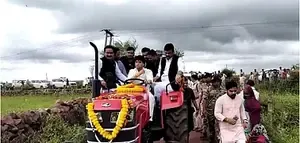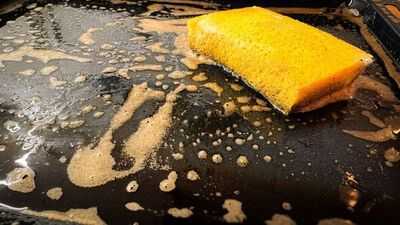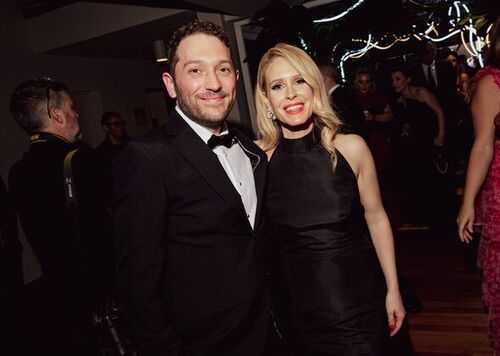
From the days of ‘ayyo rama’ wails of Mehmood, a south Indian music master in the 1968 comedy, Neglect to Shah Rukh Khan’s Tamilian video programmer Shekhar Subramaniam tucking into noodles and curds in Raode (2011), not much changes for south Indians in Bollywood.
It is not as if there are no south Indians in the Hindi film industry, who can set right some basic information that the lungi is different from the dhoti and there are more people in the south than ‘Madrasis’. Or that men wear other clothes besides these two garments, made famous by Shah Rukh and Deepika in the famous ‘lungi’ dance in Chennai Expressand women walk around without jasmine in their hair. And, not break into Mohiniyattam or Bharatanatyam moves in a flash.
The latest row over Bollywood’s lazy and ill-informed stereotyping of south Indians stems from the trailer of the upcoming romantic comedy, Param Sundari (2025). The trailer shows Jhanvi Kapoor as a Malayali girl, strutting around in a half-sari and jasmines in her hair, spouting some high-faluting knowledge about south Indian movie superstars. Many influencers have hit out at the casting of Jhanvi Kapoor and for her “inauthentic” accent, her stereotypical attire and for butchering Malayalam.
Alarms Bells have been ringing as she Introduces Herself as thekkapetta sundari Damedaran Pillai in the trailer. Many critics have questioned the name the name theskkapeta, which in Malayalam Slang as “Thekapetta sundari” translates roughly to “betrayed beauty.”
Also read: ‘The Bengal Files’ debate: Cinema, history, and responsibility
Social media has erupted and slammed the production house for not checking the meaning of the word. Moreover, she speaks in an exaggerated accented English, and broken Hindi. The trailer also includes the usual medley of Kerala visuals: Kalarippayattu, Mohiniyattam, backwaters, boat races etc.
RJ Pavithra Menon in her viral post questioned the caricaturing in the film and caustically questioned the heroine’s portrayal as a “jasmine-flower-wearing, mohiniyattam-dancing, half-sari-clad Malayali girl”. She wrote that “not all Malayali women learn classical Indian dance, nor do we prance around in gilded half-skirts with low-cut blouses.” The playful moment where she calls Sidharth’s character “mannuni,” supposedly “idiot” in Malayalam, sounded as if an alien was speaking, observed a social media user.
The trailer has received a huge backlash as users are saying this is not representation but a parody and criticised the makers of the film for not doing adequate research.
Here are other Bollywood films that parodied south Indians, not in a good way:
Do Phool (1973)
There was a song back in 1973, which sadly symbolished what the Hindi film industry thought of south Indians. This was in the film Do Phool, in which Mehmood (again) in a lungi and an ill-fitting, floppy wig, prances around on a beach with actress Anjana for the number, ‘Muthu kudika vaari ga la ‘. Influencers today would have had a field day if this song had released today.
It was the worst caricature of south Indians probably masked by the song’s popularity. All through the song, besides cavorting and embracing each other, both Mehmood and Anjana keep breaking into basic Bharatanatyam moves on a Kerala beach. This entire song has been dismissed by critics of today as “quintessential, comic stereotyping of the south”. It was certainly not flattering to south Indians in any way.
Hamara Dil Aapke Paas Hai (2000)
Somehow, Anupam Kher took Mehmood’s mantle and did many exaggerated, comical stereotypes of south Indians.
In the 1992 film Ek ladka ek ladkiKher played a “Tamil doctor” named Dr J J. Though the film was meant to be a satire, his accent, mannerisms, and overall demeanour were exaggerated for comedic effect and turned out to be a cringe fest.
In Hamara dil aapke paas haiKher is a Tamilian Muthu Pillai living in a residential colony, where the hero Anil Kapoor brings the woman (Aishwarya Rai) he has rescued from her rapist, to live.
Also read: How Hindi cinema’s patriotic songs have stirred India’s heart since Independence
Muthu Pillai in a silk gold-bordered veshti and a vibhuti smeared forehead, is desperately trying to have an affair with his neighbour’s wife. His exaggerated mannerisms and loud dialogues, ‘kaiko ji, bholo ji’, and breaking into a ‘vandana’ ( a salutation before a classical dance recital) before he prepares to jump into bed with his secret lover, are frankly grating and unfunny.
Chennai Express (2013)
Shah Rukh Khan’s ode to Tamil star Rajnikanth had more than an element of tongue-in-cheekiness in it. Somewhere, the star could not help making fun of south Indians. Though the lungi dance was put together to appease voices raised in protest about trashing south Indians in the film (a big grouse being the ugliest villains), there were tropes in the film that clearly made south Indians look like an alien, uneducated tribe from deep inside a forest.
Deepika Padukone’s heavily accented Tamil-English caricature completely overshadowed the film’s narrative as well. It was irritating and she was turned into a twittering, mindless woman. Each time, the same playbook is played out: throw in jasmine flowers, a few butchered words of the local language, and Bollywood believes they nailed South Indians.
Kisi ka bhai kisi ki jaan (2023)
Salman Khan too dissed south Indians with swag. The song Ofamma picturised on actors Salman Khan, Venkatesh Daggubati, Ram Charan, and Pooja Hegde, got people’s goat. It created ripples because Salman was wearing boots in a ‘south-Indian’ dance inside a temple and he was sporting a white dhoti like a lungi.
Wearing bright yellow shirts and white dhotis, the caricature was in such bad taste that former cricketer Laxman Sivaramakrishnan tweeted, “This is highly ridiculous and degrading our South Indian culture. This is not a lungi, this is a dhoti. A classical outfit which is being shown in a disgusting manner.” He wrote, “What kind of step is this? They’re calling veshti a lungi…and doing some sick move by putting their hands inside it. Worst (sic).”
A social media user replied to that: “Quite true bro. If we ask them, they’ll say we did a spoof on the lungi culture in the south (sic).” Someone should seriously educate Bollywood about the difference between Lungi and veshti. Veshti is a traditional wear. Seriously irritating to see these types of vulgar dance moves in traditional wear (sic).”
Users slammed Bollywood for trying to ride on the popularity of south films (the Salman movie was a remake of Tamil film Veeram) and pointed out that they still don’t understand Telugus are not Madrasis. “The blatant ignorance is annoying,” wrote one user.
Meenakshi sundareshwar (2021)
‘Meenakshi Sundareshwar’, set in Madurai, too misfired badly: both leads were North Indian, and the film was called out for its miscasting and cultural shallowness.
Sanya Malhotra reduced South Indian women to filter-coffee clichés and demure sari-clad women. Alia Bhatt in Two States(which released seven years earlier in 2014), also seemed miscast as a Tamil girl Ananya Swaminathan but the actress somehow did not get the brickbats that Sanya received for her role. But Alia Bhatt’s father in the film was meant to be a typical south Indian father, which they also got wrong.
-
VIDEO: Union Minister Jyotiraditya Scindia Inspects Flood-Hit Villages On Tractor In MP's Guna

-
Remove oven glass grease in 20 minutes with 1 common food scrap-no scrubbing needed

-
Old Money Dispute Erupts Into Gunfire, Chaos In Madhya Pradesh's Morena - VIDEO

-
Inside Jon Richardson's tense split from Lucy Beaumont including hefty payout

-
Plight of Pakistan's Buddhists and crumbling state of their heritage tell story of abandonment, marginalisation: Report
